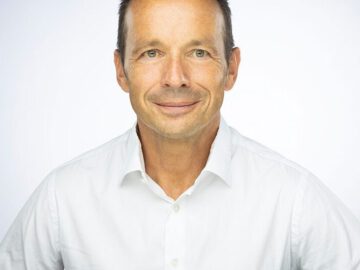Gunther Wennemuth
Univ.-Prof. Dr. med.
Anatomy
Our lab has a broad spectrum in questions concerning reproductive biology and immunology. We investigate Ion- and proton channels as crucial molecules enabling sperm to regulate all of their key functions like motility, hyperactivation or sperm-egg communication. These questions are addressed with the help of photometry in combination with pharmacological protocols. We also use all classical and modern methods of cell imaging (Immunocytochemistry electron microscopy, digital holographic microscopy), molecular biology and protein biochemistry in our lab. Our recent work concentrates on the spatial-temporal imaging of sperm movement with the help of holographic microscopy.
Most would agree that life starts with the fusion of egg and sperm. Millions of sperm are rereleased into the oviduct after ejaculation. Few have considered how the fertilizing sperm is selected from the millions of sperm released to the female genital tract. During their way along the oviduct – a journey that is equivalent to a human walking from Frankfurt to Berlin within 24 hours – many selective processes decide which sperm are possible candidates to fertilize the egg. No more than 10-20 sperm will come even close enough to have a chance to fertilize the oocyte. We plan to apply the cutting-edge technique of digital-holographic Microscopy (DHM) on sperm movement to analyze their trajectories and flagellar wave in four dimensions. We have developed this technique in the last years that far, that we cannot apply only a head tracking of the sperm but observe the whole flagellar movement in space and time in all dimensions. This with a spatiotemporal resolution which is only limited by the speed of the camera used. We could show that murine sperm have a well-defined chiral movement in the head as well as in the flagellum, which work independently from each other. In our ongoing projects we plan to apply DHM to certain and well-defined points during fertilization. Those time points will be early activation, linear movement, capacitation, sperm-egg binding/fusion, and hypermotility. We choose these time points, because they are very well defined and can easily be simulated in-vitro. We will perform these experiments in part with the help of transgenic mice which carry mutations for the CatSper channel. CatSper is across many species one of the most important ion channels for successful fertilization. We will also use sperm of other species beside mouse – like bovine, human and sea urchin to make conclusion about translational importance of our findings.We will further identify the importance of the above mentioned chiralities of the sperm head and flagellum in the light of different key functions of spermatozoa. We will specifically test the hypothesis, if altering chiralities of the head and flagellum are important for the regulation of sperm functions. We expect to generate significant new findings for the basic biological knowledge of fertilization as well as information about important factors which can lead to disturbance of sperm movement and in turn to difficulties of sperm selection during fertilization.
Das Leben beginnt mit der Fusion von Spermien und Eizelle. Millionen von Spermien werden durch die Ejakulation in den Ovidukt entlassen. Die Spermien legen danach innerhalb von 24h einen Weg zur Eizelle zurück, der einer Wanderung von Frankfurt nach Berlin entspricht. Selektionsprozesse entscheiden auf diesem Weg, welche Spermien soweit in die Nähe der Eizelle gelangen, dass diese überhaupt eine Chance haben, sie zu befruchten. Nicht mehr als 10-20 Spermien bleiben am Ende dieses Selektionsprozesses übrig. Wir planen mit Hilfe der digital-holographischen Mikroskopie (DHM) Trajektorien und Wellenbewegungen von Spermien bzw. deren Flagellen zu untersuchen. Die Methode der DHM wurde von uns so weit entwickelt, dass wir als erste Arbeitsgruppe nicht nur ein Kopf-Tracking, sondern die Bewegung des gesamten Spermiums mit Flagellum in Raum und Zeit verfolgen können. Dies mit einer spatiotemporalen Auflösung, die lediglich durch die Kamerageschwindigkeit limitiert wird. Dabei konnten wir zeigen, dass Spermien sowohl im Kopf als auch im Schwanz fest definierte Chiralitäten zeigen, die unabhängig voneinander gesteuert werden. In unseren derzeitigen Untersuchungen sollen zu definierten Zeitpunkten der Fertilisierung Schlüsselfunktionen von Spermien mittels DHM untersucht werden. Wir wählen dazu die Zeitpunkte der der frühen Aktivierung, der linearen Motilität, der Kapazitation, der Spermien-Eizellbindung und der Hypermotilität, da diese sich in vitro klar definieren bzw. simulieren lassen. Wir werden dies u.a. mit Hilfe von transgenen Tieren für CatSper durchführen, da dieser Ionenkanal speziesübergreifend von großer Bedeutung für die Befruchtung ist. In weiteren Untersuchungen werden humane, murine, bovine und auch Spermien von Seeigeln zum Einsatz kommen, um die translationale Bedeutung der von uns gemachten Beobachtungen zu beurteilen. Mit unseren Experimenten soll die Bedeutung der oben erwähnten Chiralitäten von Kopf und Flagellum unter dem Einfluss unterschiedlicher Spermienfunktionen untersucht werden. Wir möchten insbesondere die Hypothese testen, ob sich ändernde Chiralitäten von Kopf und Flagellum wichtig für Steuerung von Spermienfunktionen sind. Wir erwarten neben dem Erkenntnisgewinn zum biologischen Grundverständnis der Spermienbewegung Informationen darüber, welche Faktoren zu Störungen der Spermienbewegung führen können und so über die Selektion von Spermien während der Befruchtung entscheiden.

